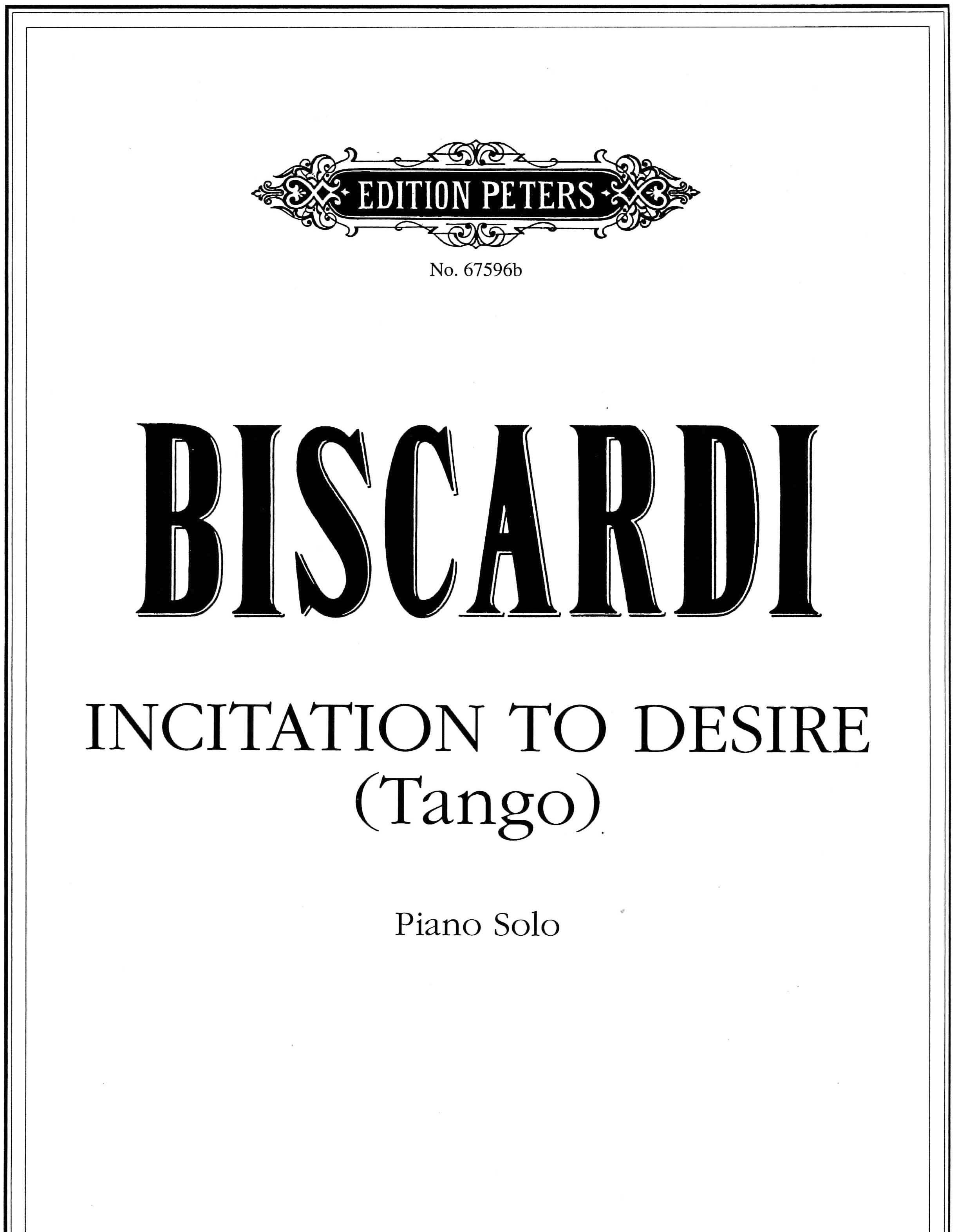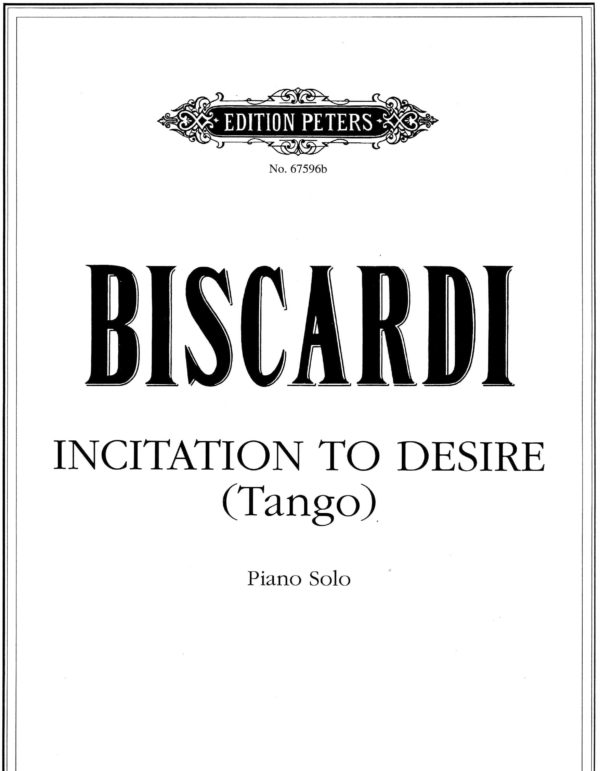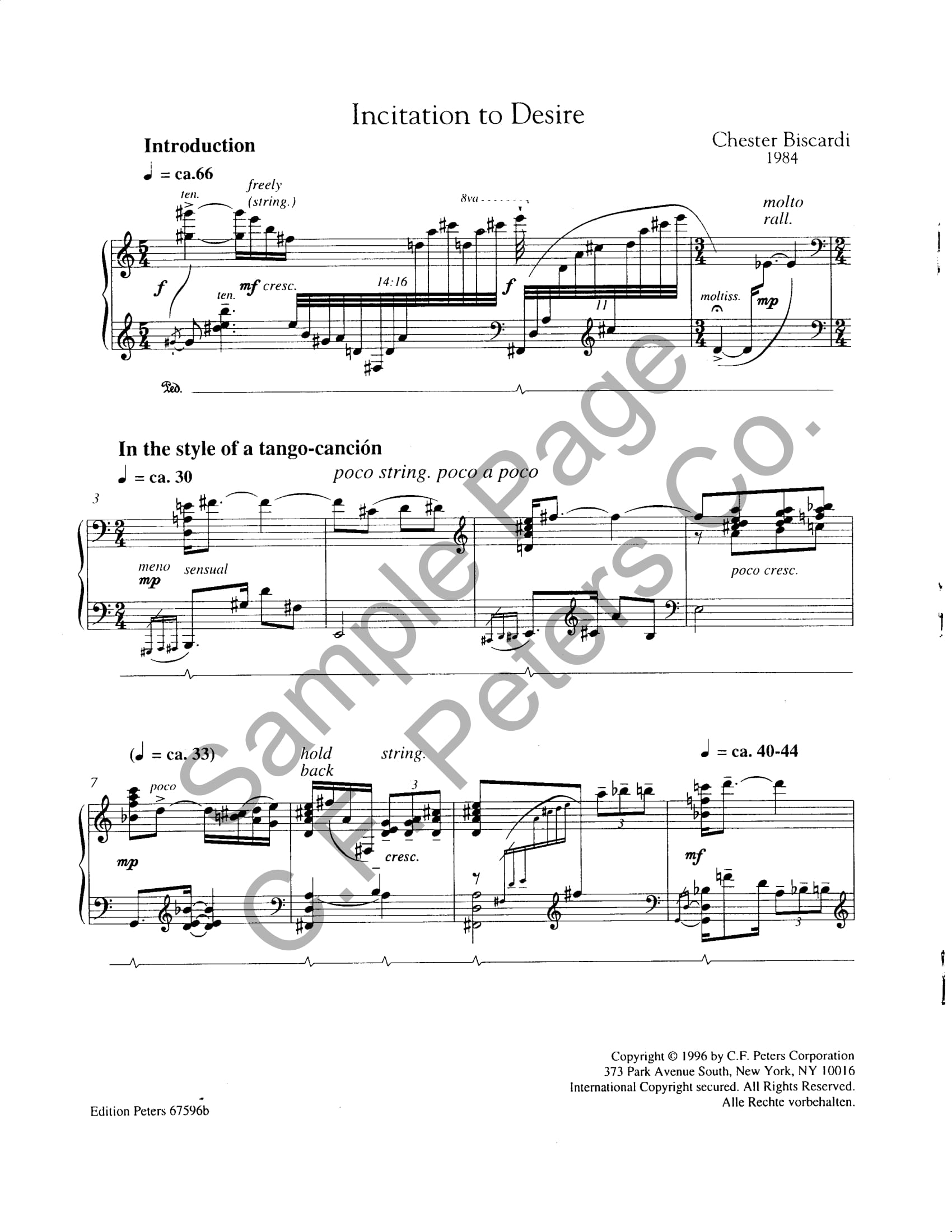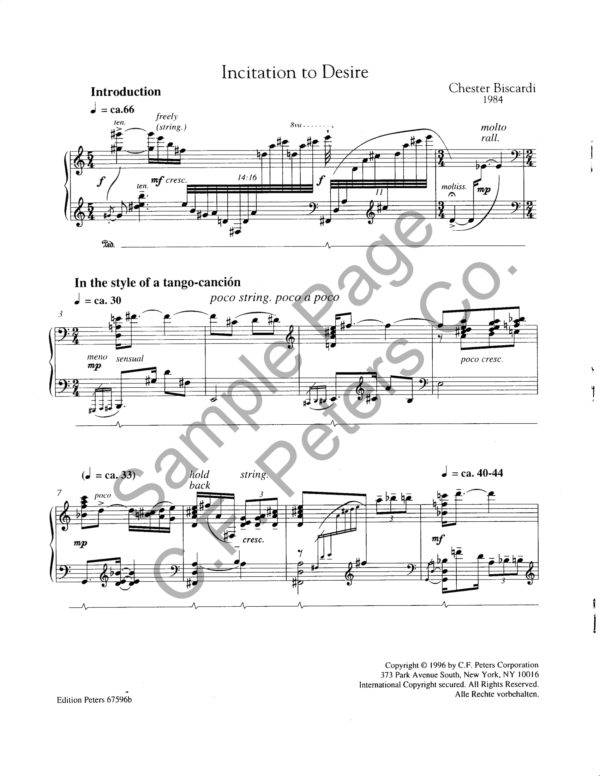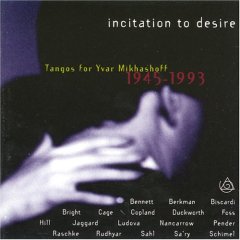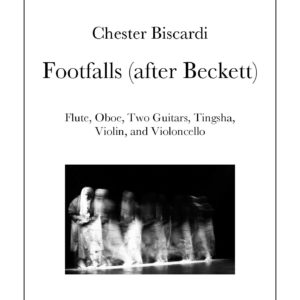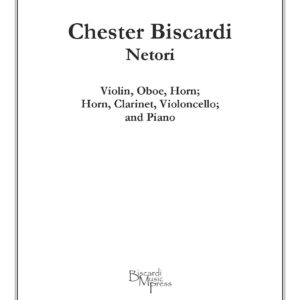Description
Audio
Yvar Mikhashoff, piano
This recording appears on
Incitation to Desire, New Albion Records, Inc. NA073CD (San Francisco, 1995) with tangos by Michael Sahl, John Cage, Dane Rudhyar, William Duckworth, William Schimel, Lukas Foss, Scott Pender, Richard Rodney Bennett, Ivana Ludova, Colin Bright, Laszlo Sa`ry, Conlon Nancarrow, Jackson Hill, Raschke, Aaron Copland, David Jaggard and Robert Berkman.
Premiere
14 April 1985
Yvar Mikhashoff, piano
North American New Music Festival
Buffalo, NY
Publisher
C. F. Peters No. P67596b
Program Notes
Incitation to Desire (Tango), for piano (1984), was written for Yvar Mikhashoff who first performed it at the North American New Music Festival in Buffalo on April 14, 1985 and whose recording of it appears on a New Albion release in 1995. It was originally published by Quadrivium Music Press as part of the International Tango Collection which included 88 composers as varied as John Cage, Karlheinz Stockhausen and Virgil Thomson. The Skaneateles Festival commissioned a version for clarinet, horn, violin, violoncello, percussion and piano which was premiered on September 3, 1993 and is dedicated to pianist Robert Weirich and ‘cellist Lindsay Groves; a version for solo marimba, commissioned by Makoto Nakura, was first performed in Kyoto on June 11, 2006. It is in one short movement starting with a brief, flashy introduction, then the tango itself entitled "In the style of a tango-canción" (originally a vocal form with instrumental accompaniment and strong sentimental character) with abstracted characteristic habanera rhythmic patterns in 2/4 meter and sentimental melody, and then a brief, driving coda. The title comes from H. C. Colles’ "Tango" entry in the Fifth Volume of the 1944 Third Edition of Grove’s Dictionary of Music and Musicians: "The movements of the dance are less presentable to a polite audience than those of the Habanera, and as now performed in the cafés chantants of Madrid and other cities of Spain the Tango has become nothing but an incitation to desire."
Videocassette: 88 Tangos, March 1, 1986, (Yvar Mikhashoff, piano; Jeff Fontaine, lighting), Dance Theater Workshop and Composers’ Forum; Nominated in the Best Instrumental Performance Category, 2nd Annual Gay/Lesbian American Music Awards (GLAMA), 1998, for Incitation to Desire (Tango), for piano (1984), performed by Anthony de Mare on Gay American Composers (CRI CD 721).
Press
"Beguiling, eminently programmable, and performable, the piece might energize a standard solo recital."
— Clavier (1996)
"Biscardi's
Incitation to Desire (Tango) evokes the steamy sultriness and sad nostalgia of the Argentinian dance."
— John Salmon, Piano & Keyboard (1997)
"This short dance in one movement opens with a brief, brilliant introduction, followed by the tango itself (identified as 'in the style of a tango-canción' — a vocal form with a strong sentimental character), concluding with a short, driving coda. The introduction is a brief, grand flourish, and the main body of the dance alternates between passages of irresistible tango rhythm and brief cadenza-like outbursts (perhaps representing the momentary submission of the dancers to desire). In a forceful coda, guitarlike chords attempt to propel the dance back into frenzied passion, but the new, calmer mood proves inescapable.
"The need for rhythmic control in a somewhat free setting, the extremely specific demands for articulations and dynamics, and the brilliancy of the quasi-cadenzas underscore the technical difficulties of this piece. One page of performance notes explains the differences between the carefully notated gradations for both articulations and dynamics and suggests that performers apply a flexible interpretation to both dynamics and tempos."
— William T. Spiller, Notes (1998)
" . . . the lascivious
Incitation to Desire of Chester Biscardi."
— Peter Grahame Woolf, Classical Music on the Web (2000)
"Biscardi has written a sultry, modern tango — a real charmer."
— Lawrence Budmen, Music and Vision Daily (2003)
Incitation to Desire (1984) was written for Yvar Mikhashoff's Tango Project, though its relation to the dance is less in the rhythms than in the sense of superheated Romantics.
— Robert Carl, Fanfare, The Magazine for Serious Record Collectors (1995)
In what appear to by transitional pieces -
Incitation to Desire (1984),
Traverso, for flute and piano (1987), and
Companion Piece (1991), Biscardi's harmonies, no matter how arcane, show themselves to be never farther than the proverbial hair's breadth for the mainstream diatonicism that has informed so much of music's recent history. His subtle and often telling vacillation between these at once vastly separated and extremely close harmonic realms imbues these pieces with dynamism and expressiveness.
— William Zagorski, Fanfare, The Magazine for Serious Record Collectors (1995)
A short 1984 piano piece by Mr. Biscardi, Incitation to Desire: Tango [
sic], was a delicious send-up of grand romanticism. And Mr. Bray [of Voices of Change] played it accordingly. Mr. Bray had the happy idea of having it danced. Doug Hopkins, from the Bruce Wood Dance Company, supplied deft, provocative counterpoint of his own.
— Scott Cantrell, The Dallas Morning News (2003)
. . . the 1984 piano solo Incitation to Desire: Tango [
sic] displayed full, luxuriant romanticism. (Fort Worth-based dancer Doug Hopkins, a member of the Bruce Wood Dance Company, choreographed and danced a sturdy, occasionally whimsical setting to the piece that gave a solid and appropriate contrast to Biscardi's florid music.)
— Wayne Lee Gay, Fort Worth Star-Telegram (2003)
Chester Biscardi's
Incitation to Desire supplies an evocative title for the CD and a kind of stylistic locus for the many ideas of tango on it. Born in 1948 in Kenosha Wisconsin, he holds the William Schuman Chair in Music at Sarah Lawrence College. His earlier music was "abstract and atonal, but always lyrical and dramatic." Like Michael Sahl, he has over time absorbed "modernisms;" his music is elegant; the chromaticism more Continental than Sahl's, less jazz-tinged. He provides some background and the source of his title:
Incitation to Desire ... was written for Yvar Mikhashoff who first performed it at the North American New Music Festival in Buffalo on April 14, 1985. The title comes from H. C. Colles' "Tango" entry in the Fifth Volume of the 1944 Third Edition of Grove's Dictionary of Music and Musicians: "The movements of the dance are less presentable to a polite audience than those of the habanera, and as now performed in the cafés chantants of Madrid and other cities of Spain the Tango has become nothing but an incitation to desire."
At a compact 54 bars,
Incitation to Desire is built on sections of 2/4 melody "in the style of a tango-canción" (as the score indicates) invoking the sentimental side of tango. The tune appears in several different shapes; initially a seven measure melody, it is then embellished and extended in a variety of ways – "composed" rubato, 3/4 bars at section endings and longer measures of improvisatory arpeggiation. Never repeated in quite the same shape or key, a sense of restless energy and unresolved tension prevails. Abstracted, constantly shifting
tango-habanera rhythms and unresolved extended dominant chords contribute to these effects, with as much of Debussy as Gardel.
There is something quite compelling about this combination of dreamy languor and precise, self-assured piano writing; Biscardi has captured an essence of tango without assembling one from old parts or straining for originality. One had to ask, might there be anything of a certain Argentinian in his approach? The composer was parsimonious: "I can't speak to the Piazzolla, I'm afraid."
— Jared Newman, After Astor Piazzolla: Contemporary American Tangos in the Yvar Mikhashoff Collection (2004)
The second night of Keys to the Future began with Chester Biscardi's
Incitation to Desire, a modern tango with the sensuality of a daydream. Pianist David Friend (winner of the festival's first Young Artists Competition), after perhaps a slight bit of "yikes, I'm opening the concert" palpitations, ultimately handled its jazzy spirit with care, settling into Biscardi's burnt-orange universe of florid chords.
— Bruce Hodges, "Seen and Heard International Concert Review,", MusicWeb International's Worldwide Concert and Opera Reviews (2008)
There is a vast stylistic range presented here, from Chester Biscardi’s evocative
Incitation to Desire, one of the earliest commissions and one of the least overtly reminiscent of the tango’s distinctive rhythm, to the serial approach of Milton Babbitt’s
It Takes Twelve to Tango, the minimalism of Tom Johnson’s
Tango, the moto perpetuo of Scott Pender’s
Tango: Ms. Jackson Dances for the People (referencing Janet Jackson’s What Have You Done For Me Lately) and Frederic Rzewski’s rhythmic, lilting,
Steptangle.
— David Olds, The WholeNote (2019)
Hanna Shybayeva plays Chester Biscardi’s
Incitation to Desire note perfectly, yet Yvar Mikhashoff’s sexy inflections and pointing up of juicy cadences are much closer to the music’s curvaceous mark.
— Jed Distler, Classics Today (2019)
Jeanne Golan’s
IT TAKES ONE TO TANGO: Works of Contemporary and Recovered Voices Composers is a collection you’re . . . likely to remember for its poise (listen to her soufflé performance of the Tango from the Grosz Suite and her seductive reading of Chester Biscardi’s evocatively slow-burning
Incitation to Desire).
— Peter J. Rabinowitz, Fanfare Magazine (November/December 2021)
The most valuable musicians and music people to me these days are those with the courage and insightful instincts when it comes to music we may have missed or not yet heard.
— Grego Applegate Edwards, Gapplegate Classical-Modern Music Review (It Takes One to Tango) (December 2021)
The title of Biscardi's
Incitation to Desire derives from a 1944
Grove Dictionary of Music characterization of the tango as “less presentable to a polite audience” than the habanera and as “nothing but an incitation to desire”; there's certainly little that's vulgar about Golan's enticing rendering of the romantic setting, however.
— textura (It Takes One to Tango) (January 2022)

